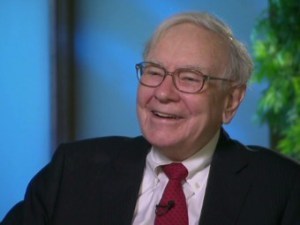Stewart Brand's Blog, page 77
February 13, 2013
TimesMachine: “All the News That Was Fit to Print”
If you’re a fan of this video showing a years’ worth of front pages for NYTimes.com, or the Way Back Machine, which allows you to browse the internet of the past, you might also love a project released by the New York Times today: The TimesMachine.
TimesMachine can take you back to any issue from Volume 1, Number 1 of The New-York Daily Times, on September 18, 1851, through The New York Times of December 30, 1922. Choose a date in history and flip electronically through the pages, displayed with their original look and feel.
You’ve got to be a subscriber to access most of the content, but issues from several important days in history are freely available in their entirety:

Buffett pulls ahead in wager against hedge funds
In 02008, Warren Buffet placed a Long Bet that will take until 02017 to resolve. He predicted that for those ten years, “the S & P 500 will outperform a portfolio of funds of hedge funds, when performance is measured on a basis net of fees, costs and expenses.”
Below is a summary of how things went in the fifth year of this Bet, as published by Fortune Magazine:
Five years into a ten-year bet that an S&P index fund can beat hedge fund funds-of-funds, Warren Buffett is in the lead for the first time.
By Carol Loomis
FORTUNE — It’s halfway time in the 10-year stock market wager sometimes called The Million-Dollar Bet—that’s Warren Buffett backing the performance of an S&P index fund vs. a New York money manager backing five funds of hedge funds—and there’s double-barreled news.
Item One: For the first time since the bet started five years ago, Buffett has moved ahead—by an okay margin to boot. Item Two: For the first time ever as well, both sides have crawled out of the ditch (though the funds of funds barely made it) and are showing positive results.
About that history of bad results, of course, you need to keep in mind that this bet started in the gut-wrenching year of 2008, which left both contenders deep in the red. Buffett, though, was definitely a deeper shade of red: Vanguard’s Admiral shares—the S&P index fund he’d backed—lost 37% in 2008 vs. a 24% drop, on the average, for Protégé’s five funds of funds.
Reporting on that first year of the bet, Fortune quoted Buffett as just hoping he could be like the fabled tortoise that ultimately passes the hare.
So now the tortoise, after crawling four more years, indeed leads. At the five-year mark, the Vanguard index fund backed by Buffett is up by 8.69%. The five funds of funds picked by Protégé Partners to carry its flag in the race are up, on the average, only—”gulp,” says Protégé partner Ted Seides—0.13%.
By the terms of the bet, the identity of those five funds has never been made public. It has always been assumed, however, that one of them is a fund of funds run by Protégé itself.
The strength of 2012′s stock market is naturally what carried the contestants into the black. The market’s vigor is displayed in the performance of the index fund, which rose by 15.96% last year. In contrast, the five funds of funds managed a 2012 gain, on the average, of only 6.46%.
From his trailing position, and probably having heard enough about the tortoise, Protégé’s Seides imagines an alternative future for the bet by recalling the movie, City Slickers. In it, says Seides, “Billy Crystal’s character asks Jack Palance’s character, Curly, if he has killed anyone today—and Curly answers, ‘Day ain’t over yet.’”
We’ll let that suspense hang and report still one more piece of news about this bet. This bulletin concerns the 10-year zero-coupon bond that the two bettors, Buffett and Protégé, bought with the collateral they put up as the bet began. Each contributed about $320,000, so a total of roughly $640,000 went into the bond. Its value was set to rise gradually to $1 million—thus the nickname for the bet—by its conclusion on December 31, 2017.
But as Fortune.com reported last year (Buffett gains ground in hedge fund bet), the zero-coupon bond proceeded to perform so splendidly in the prevailing environment of falling interest rates that by 2012 it was already worth almost $1 million.
That remarkable result suggested to Buffett and Protégé that they could revise the terms of the bet and quite possibly get more than $1 million to the charity ultimately benefitting from the bet. That will be Girls Inc. of Omaha if Buffett wins and Absolute Returns for Kids if the victor is Protégé.
So the zero-coupon bond was sold for nearly $1 million toward the close of 2012, and by agreement between Buffett and Protégé, the proceeds were put into the B stock of Buffett’s company, Berkshire Hathaway (BRKA). Berkshire’s shares have risen since, and the current value of the investment is well over $1 million.
And couldn’t the stock fall? It certainly could, but that won’t make a whit of difference to the winning charity—because Buffett has guaranteed that it will get at least $1 million at the end of the bet. On the upside, meanwhile, there’s no ceiling on what the charity can walk away with. That depends simply on what happens to Berkshire’s stock between now and the bet’s conclusion.
Fortune senior editor-at-large Carol Loomis, who wrote this article, is a longtime friend of Warren Buffett’s, a Berkshire Hathaway shareholder, and editor of his annual letter to shareholders.

February 12, 2013
The Returning Tree
The Returning Tree from YuriSerizawa on Vimeo.
Digital artist Yuri Serizawa created this visualization as his graduation work at Digital Hollywood. It blends the biological with the urban and set the stage for our June 02012 SALT talk with Benjamin Barber on the role of cities in the future, “If Mayors Ruled the World.” We screened it at the seminar as part of our Long Shorts series of short films that convey long-term thinking.

February 11, 2013
Ecosystem in a Bottle
It’s the ultimate low-maintenance houseplant: a spiderwort that waters itself.
David Latimer, a retired resident of Surrey, UK, created this self-sustaining garden “out of idle curiosity.” In 01960, he decided to fill a large glass carboy with some compost, planted a seedling, and gave it a quarter pint of water. He watered it once more in 01972, then sealed the container shut. Since then, the spiderwort has developed its very own, independent ecosystem.
As the Daily Mail explains, this microgarden refreshes its own air and provides its own water; all it needs is a bit of solar power. Sunlight provides the energy required for photosynthesis – the process whereby a plant sustains itself by converting water and carbon dioxide into nutrients and oxygen. Bacteria in the soil offer a little help in driving this cycle of energy conversion: consuming that oxygen, they digest dead leaves that fall to the ground, and release carbon dioxide back into the air.
But what truly allows it to nourish itself is the enclosed spiderwort’s remarkably efficient ability to recycle water. Its roots draw moisture from the soil, which is then transpirated back into the air by its leaves. As this moisture condenses, it is reabsorbed into the soil, and ready to begin its cycle all over again.
Latimer’s self-sustaining microcosm demonstrates plants’ remarkable efficiency in recycling natural resources and surviving in isolated environments. There is much we can learn from this – and indeed, NASA has indicated an interest in experimenting with such gardens in space.
“Plants operate as very good scrubbers, taking out pollutants in the air, so that a space station can effectively become self-sustaining … This is a great example of just how pioneering plants are and how they will persist given the opportunity.”
Interested in bottling your own garden? The daily mail offers a video tutorial to get you started.

February 8, 2013
Long Bets – 02013 Update
Predicting the future is hard.
Long Bets is a project by The Long Now Foundation that is testing how hard it really is, and maybe making us just a little bit better at it. The site allows users to post Predictions of at least two years’ duration. Should someone disagree with the likelihood of a prediction, they are welcome to Challenge it and produce a Bet. Real money is put on the line and eventually goes to a charity nominated by the winner.
We’ve recently made judgments on several Bets and wanted to review the outcomes:
Russian software industry fails to take global lead – Long Bet 5
First 5-year decline in US vehicle miles traveled since WWII – Long Bet 197
US Presidential election process largely unchanged in 02012 – Long Bet 291
We’re also starting a Facebook Page for making and discussing predictions about the future.

Long Predictions Facebook Page
We’re going to try something new for a little while – we’ve created a Facebook Page called Long Predictions where we’ll post predictions from the Long Bets site, on the web or in the media.
We’re interested in fostering thoughtful, respectful discussion about the future and our culture’s hopes, fears and assumptions about it. We encourage you to share predictions you discover or overhear and to discuss those posted by others. You’re also welcome to venture your own prognostications and to consider taking them over to Long Bets to formally put them on record.

February 7, 2013
US Presidential election process largely unchanged in 02012 – Long Bet 291
In 02007, political tensions were running high and the US was beginning to contemplate who would replace the second President Bush. Amid this polarized climate, Jason Galbraith predicted that,
Neither major U. S. political party will hold conventions or indeed primaries to select their 2012 Presidential nominees.
Unconvinced by Galbraith’s premonitions of anarchy, coups or shadowy pseudo-democracy, Sam Stigler offered a simple rejoinder:
Galbraith’s argument fails to take into account the incredible resilience of the U.S. institutions of government over the years since its inception.
Stakes were set at $500, half from each participant.
Despite great division in the political sphere and unprecedented international crises abroad, the dramatic upheavals within the US imagined by Galbraith failed to materialize. The customary primaries and conventions were held in 02012 as usual:
Winner: Sam Stigler, Challenger
The winnings of this Bet ($500 plus half the accrued interest) will go to Lewis & Clark College.

First 5-year decline in US vehicle miles traveled since WWII – Long Bet 197
In 02005, Daniel K. Simon, believing the effects of Peak Oil to be close at hand, wrote,
The U.S Department of Transportation Bureau of Transportation Statistics (www.bts.gov) will report a lower number of total highway vehicle miles traveled in 2010 than in 2005.
His Challenger, Glen Raphael, responded,
“Five years is too short to expect much change in this area – we may not even have peaked by then. But once we do peak, it won’t be much of a problem.”
The two agreed to $400 stakes for the wager; each put in $200.
Adjudication of this Bet proved interesting: Vehicle Miles Traveled in the US have followed a surprising regular upward curve, for as long as they’ve been tabulated, with only a few deviations from the trend. One of those deviations began in 02008. Why? While the nature of peak oil is such that it will be hard to identify until afterwards, the timing of the recent dip in VMT seems to implicate the recent economic recession more than anything else. Regardless, the Bet is about the numbers, not causation or correlations.
VMT was 3.005 trillion miles in 02005 and it climbed to 3.049 trillion in 02007. The following year, 02008, was the first since 01980 to be lower than the one before it. The drop that one year was more than the growth of the previous two and 02009 continued the downward trend. 02010 – the decisive year for our purposes – showed signs of recovery and according to preliminary reports looked to have just barely surpassed 02005’s level. Once the final official tally was released though, it came to 2.9851 trillion miles: below 02005’s level. Despite a few dips in the 01970s, 02005-02010 was the first 5 year period with a net decrease in VMT since WWII.
Winner: Daniel K. Simon, Predictor
The winnings of this Bet ($400 plus half the accrued interest) will go to the Post Carbon Institute.

Russian software industry fails to take global lead – Long Bet 5
This was one of the our first Long Bets, made in 02002. Over ten years ago now, Esther Dyson predicted that,

“By 2012, the Wall Street Journal and the New York Times will have referred to Russia as “the world leader in software development” or words to that effect.”
She was challenged by Bill Campbell, who argued,
“As long a there is business opportunity… and I am confident that there will be… the US will provide world leadership in software development.”
He backed up his argument by putting in stakes of $5,000, which Dyson matched.
In reviewing the Bet, we found no such remarks in either publication. American software companies like Google and Facebook remain dominant in the American press. Many countries are contributing more and more to the global IT industry, but none as much as India, according to this graph generated from IMF data.
Winner: Bill Campbell, Challenger
The winnings of this Bet ($10,000 plus half the accrued interest) will go to the Computer History Museum.

Chris Anderson Seminar Primer
Tuesday February 19, 02013 at the Lam Research Theater at YBCA, San Francisco
Long Now emeritus board member Chris Anderson originally earned his marks in publishing, starting as an editor of Science, Nature, and The Economist before taking the helm of Wired magazine. It was at Wired that Anderson became an unofficial evangelist of the Maker’s movement, becoming so deeply involved that he recently quit his day job as Editor to join a 22-year-old from Tijuana in running a “Makers” firm, 3D Robotics. Anderson’s current prognosis for the future focuses on how the Maker’s movement will change the world of objects that surround us:
Here’s the history of two decades in one sentence: If the past 10 years have been about discovering post-institutional social models on the Web, then the next 10 years will be about applying them to the real world.
Anderson’s book THE LONG TAIL chronicled how the web revolutionized and democratized content distribution. For most of history, to publish content one required a factory, complete with the bureaucratic systems that surround such institutions. When the first desktop laser printer became accessible, it created a new wave of self publishing. Nearly thirty years later, all we need to do is click a “publish” button in WordPress. Anderson’s new book MAKERS shows how the same thing is happening to manufacturing, with even wider consequences for the world:
Transformative change happens when industries democratize, when they’re ripped from the sole domain of companies, governments, and other institutions and handed over to regular folks. The Internet democratized publishing, broadcasting, and communications, and the consequence was a massive increase in the range of both participation and participants in everything digital — the long tail of bits. Now the same is happening to manufacturing — the long tail of things.
It all started when Anderson wanted to find some new science projects to work on with his kids. He bought a 3d printer (check out the demo below) and found a series of projects that were kid-friendly. Although his kids often quickly lost interest in the various projects he started, Anderson realized that technologies like 3D printers were more than just hobbyist niches. They were the beginnings of a system that has the power to disrupt established systems of manufacturing. MAKERS shows how new systems of funding (kickstarter, crowdfunding), open-sourced design communities (thingiverse.com), and new manufacturing technologies (3d printers, laser cutters, web-integrated small-batch factories) together allow for the radical democratization of manufacturing:
The collective potential of a million garage tinkerers is about to be unleashed on the global markets, as ideas go straight into production, no financing or tooling required. “Three guys with laptops” used to describe a Web startup. Now it describes a hardware company, too.
Chris Anderson will discuss the coming “Maker’s Revolution” and how it will affect our systems of manufacturing on February 19th at the Lam Research Theater at YBCA. You can reserve tickets, get directions, and sign up for the podcast on the Seminar page. This talk is in partnership with Yerba Buena Center for the Arts and we would like to extend a special welcome to the YBCA:YOU members. We would also like to welcome members of General Assembly. Check your email for special ticketing instructions.

Stewart Brand's Blog
- Stewart Brand's profile
- 291 followers












